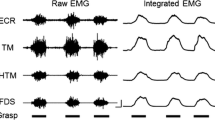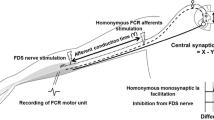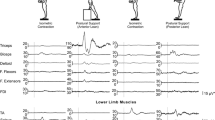Summary
Reflex EMG responses to angular displacements of the wrist joint were recorded from 12 normal human volunteers. A mechanical stop was used to suddenly arrest displacements at varying times following the onset of the stimulus. With unrestricted movement of the handle, the EMG response consisted of an early component (M1) with a latency of 30–35 ms and a long-latency component (M2–3) beginning 55–65 ms after the onset of the displacement. When the displacements were arrested prior to a critical time occurring between 40 and 50 ms after the onset (mean of 44 ms), the M2–3 component of the response was not present. Increasing the duration of the displacement beyond this time resulted in a rapid increase in the size of M2–3. Facilitation provided by volitional intent to oppose the perturbation was not sufficient to generate an M2–3 response to either a brief, low velocity displacement produced by the torque motor or to a phasic, high velocity stretch produced by a tendon tap.
The timing relationships between the onset latency of M2 and the minimum duration of displacement required to generate an M2–3 response are not easily reconciled with the notion that the segmentation of the EMG responses into components is mediated by repeated activation of the same central reflex pathway by phasic afferent bursts. Two mechanisms that could account for these results are either inhibition in response to the sudden stop of phasically-active “linking” interneurons which are part of the long latency pathway, or the loss of an essential convergent facilitatory input which serves to monitor the continuation of the movement.
Similar content being viewed by others
References
Bawa P, Tatton WG (1979) Motor unit responses in muscles stretched by imposed displacements of the monkey wrist. Exp Brain Res 37: 417–437
Burke D, Hagbarth KE, Lofstedt L (1978) Muscle spindle responses in man to changes in load during accurate position maintenance. J Physiol (Lond) 276: 159–164
Chan CWY, Kearney RE, Melvill Jones G (1979a) Tibialis anterior response to sudden ankle displacements in normal and Parkinsonian subjects. Brain Res 173: 303–314
Chan CWY, Melvill Jones G, Kearney RE, Watt DGD (1979b) The ‘late’ electromyographic response to limb displacement in man. I. Evidence for supraspinal contribution. Electroencephalogr Clin Neurophysiol 46: 173–181
Conrad B, Meyer-Lohmann J, Matsunami K, Brooks VB (1975) Precentral unit activity following torque pulse injections into elbow movements. Brain Res 94: 219–236
Cooke JD, Eastman MJ (1977) Long loop reflexes in the tranquilized monkey. Exp Brain Res 27: 491–500
Desmedt JE, Godaux E (1978) Ballistic skilled movements: load compensation and patterning of the motor commands. In: Desmedt JE (ed) Progress in clinical neurophysiology, vol 4. Karger, Basel, pp 21–55
Evarts EV (1973) Motor cortex reflexes associated with learned movement. Science 179: 501–503
Ghez C, Shinoda Y (1978) Spinal mechanisms of the functional stretch reflex. Exp Brain Res 32: 55–68
Gottlieb GL, Agarwal GC (1979) Response to sudden torques about ankle in man. Myotatic reflex. J Neurophysiol 42: 91–106
Hagbarth KE, Hagglund JV, Wallin EU, Young RR (1981) Grouped spindle and electromyographic responses to abrupt wrist extension movements in man. J Physiol (Lond) 312: 81–96
Hagbarth KE, Young RR, Hagglund JV, Wallin EU (1980) Segmentation of human spindle and EMG responses to sudden muscle stretch. Neurosci Lett 19: 213–217
Hammond PH (1954) Involuntary activity in biceps following the sudden application of velocity to the abducted forearm. J Physioh (Lond) 127: 23–25P
Hammond PH (1956) The influence of prior instruction to the subject on an apparently involuntary neuromuscular response. J Physiol (Lond) 132: 17–18P
Hendrie A, Lee RG (1978) Selective effects of vibration on human spinal and long-loop reflexes. Brain Res 157: 369–375
Iles JF (1977) Responses in human pretibial muscles to sudden stretch and to nerve stimulation. Exp Brain Res 30: 451–470
Lee RG, Tatton WG (1975) Motor responses to sudden limb displacements in primates with specific CNS lesions and in human patients with motor system disorders. Can J Neurol Sci 2: 285–293
Lee RG, Tatton WG (1978) Long loop reflexes in humans: clinical applications. In: Desmedt JE (ed) Cerebral motor control in man: Long loop mechanisms. Progress in clinical neurophysiology, vol 4. Karger, Basel, pp 334–341
Marsden CD, Merton PA, Morton HB (1972) Servo action in human voluntary movement. Nature 238: 140–143
Marsden CD, Merton PA, Morton HB (1976) Stretch reflex and servo action in a variety of human muscles. J Physiol (Lond) 259: 531–560
Marsden CD, Merton PA, Morton HB, Adam J (1977a) The effect of posterior column lesions on servo responses from the human long thumb flexor. Brain 100: 185–200
Marsden CD, Merton PA, Morton HB, Adam J (1977b) The effect of lesions of the sensorimotor cortex and the capsular pathways on servo responses from the human long thumb flexor. Brain 100: 503–526
Melvill Jones G, Watt DGD (1971) Observations on the control of stepping and hopping movements in man. J Physiol (Lond) 219: 709–727
Miller AO, Brooks VB (1981) Late muscular responses to arm perturbations persist during supraspinal dysfunction in monkeys. Exp Brain Res 41: 146–158
North AGE, Tatton WG (1980) Temporal relations between motor cortical and electromyographic responses to imposed forelimb displacements in the cat. Soc Neurosci Abstr 6: 392
O'Rain M, Blair RDG, Murphy JT (1978) The EMG response to sudden stretches of limb muscles in normal human subjects. Can J Physiol Pharmocol 56: 771–776
Rothwell JC, Traub MM, Marsden CD (1980) Influence of voluntary intent on the human long-latency stretch reflex. Nature 286: 496–498
Stanley EF (1978) Reflexes evoked in human thenar muscles during voluntary activity and their conduction pathways. J Neurol Neurosurg Psychiat 41: 1016–1023
Tatton WG, Bawa P, Brace IC, Lee RG (1978) Long-loop reflexes in monkeys: An interpretative base for human reflexes. In: Desmedt JE (ed) Progress in clinical neurophysiology. Karger, Basel, pp 229–245
Tatton WG, Bawa P (1979) Input-output properties of motor unit responses in muscles stretched by imposed displacements of the monkey wrist. Exp Brain Res 37: 439–457
Tatton WG, Forner SD, Gerstein GL, Chambers WW, Liu CN (1975) The effect of postcentral cortical lesions on motor responses to sudden limb displacements in monkeys. Brain Res 96: 108–133
Tatton WG, Lee RG (1975) Evidence for abnormal long-loop reflexes in rigid Parkinsonian patients. Brain Res 100: 671–676
Tracey DJ, Walmsley B, Brinkman J (1980) “Long-loop” reflexes can be obtained in spinal monkeys. Neurosci Lett 18: 59–65
Upton ARM, McComas AJ, Sica REP (1971) Potentiation of late responses evoked in muscle during effort. J Neurol Neurosurg Psychiat 34: 699–711
Vilis T, Cooke JD (1976) Modulation of the functional stretch reflex by the segmental reflex pathway. Exp Brain Res 25: 247–254
Author information
Authors and Affiliations
Additional information
This research was supported by Medical Research Council of Canada grants MA 4209 and MA 5218
Rights and permissions
About this article
Cite this article
Lee, R.G., Tatton, W.G. Long latency reflexes to imposed displacements of the human wrist: Dependence on duration of movement. Exp Brain Res 45, 207–216 (1982). https://doi.org/10.1007/BF00235780
Received:
Issue Date:
DOI: https://doi.org/10.1007/BF00235780




